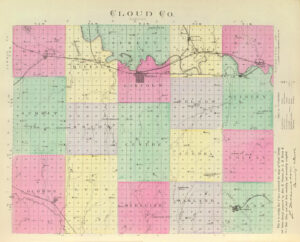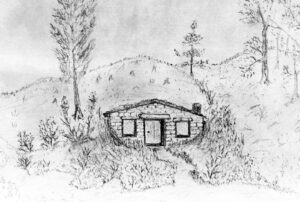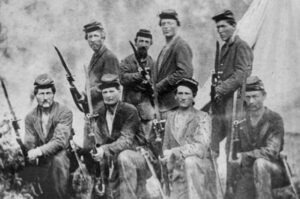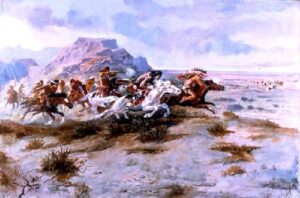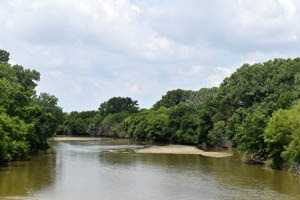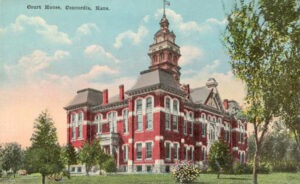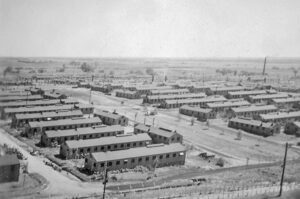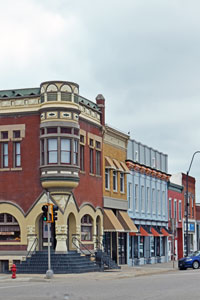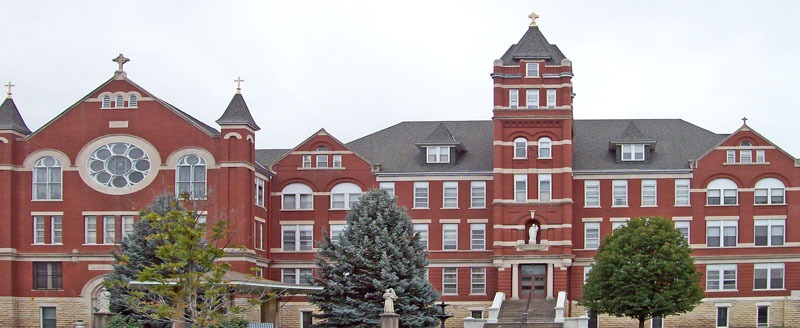
Nazareth Convent & Academy, in Concordia, Kansas, by Paul McDonald, Wikipedia.
Towns & Places:
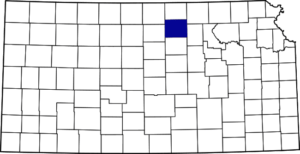
Location of Cloud County, Kansas.
Ames – Unincorporated/Extinct
Aurora
Clyde
Concordia – County Seat
Glasco
Jamestown
Miltonvale
Simpson
Cloud County, located in north-central Kansas, in the second tier of counties south of Nebraska, was created out of the unorganized territory by a legislative act of February 27, 1860. The county was initially named Shirley, but some civic leaders thought it sounded too much like the name of a prostitute. On February 26, 1867, the name was changed to Cloud in honor of William F. Cloud, a colonel of the Second Kansas Cavalry.
On February 4, 1865, the boundary lines of Washington County were extended to include the counties of Shirley and Republic, provided, “however, that at any time in the future, when the territory now comprised either in the County of Shirley and Republic shall contain the number of inhabitants that shall entitle them to a County organization, they shall be authorized to organize and become a distinct County.”
It is believed that the first white men to visit the area were French traders who passed through on the Republican and Solomon Rivers early in the 18th century. A Spanish expedition from New Mexico later passed through Cloud and Republic Counties early in September 1806, when Zebulon Pike’s expedition was encamped on the Solomon River.
Some of the first permanent settlers in Cloud County were Lee Fowler, his brother, and John and Harlow Seymore, who came in 1858 to hunt and trap. C.W. Brown followed them. The Fowlers were single men, but Brown brought his family with him. When these men came to Cloud County, they were supposed to have been the only settlers west of the 6th principal meridian. Within a short time, the Fowler brothers built what afterward became known as the “Conklin House” and platted a townsite called Eaton City. This was the first real house in the county and was located in the western part of the present city of Clyde. Brown and Seymore settled first on Peach Creek and then on Elk Creek. The surveyors who laid out Eaton City were Sylvanus Furrows and a man named Starr, but the Fowlers did not file on the claims before they enlisted in a Kansas regiment at the outbreak of the Civil War. In the autumn of 1865, they returned to the county but found that others had taken their claims.
The county was created on February 27, 1860, as Shirley County, and its county seat was set at Clyde.
Early in the spring of 1860, John Allen of Kentucky and his son-in-law, Sutton McWhorter, took up claims north of Lake Sibley on the military road to Fort Kearny, Nebraska, and laid out a town called Union City. Allen brought some fine-blooded cattle, the first of which was introduced into the area. Other settlers were Thomas Heffington, who later moved to Elk Creek; Joseph Finney on Elk Creek; and John Sheets on Elm Creek. Philip and Carey Kizer, along with Newton Race and their families, accompanied by some hired help and 40 head of cattle, passed up the Republican Valley and located on White Rock Creek about three miles from its mouth. Daniel Wolf and several sons from Pennsylvania settled a few miles south of the present city of Concordia on a creek that bears their name. Jacob Heller settled on Elk Creek, followed by his father and brothers. J.M. Hageman, J. M. Thorp, and August Fenskie made improvements on their land and were the first to raise marketed crops. In July 1860, some settlers left due to an Indian scare, and with an estimated population of only 80, the settlement briefly fell below that number.
In 1862, Richard Coughlen, John D. Robertson, Zachariah Swearingen, and their families joined the frontier settlement. During that year, Charles and Peter Conklin, with two sisters and an orphan child, took up their residence in the log house built by the Fowlers, which was the best in the county. These men were suspected of being members of an organized band of horse thieves, and as the county was yet unorganized, the settlers took the law into their own hands. A party of some 30 men from Washington and Cloud Counties was organized to lynch the Conklins, but they heard of the plan and escaped. The mob then tore down the house, sheltering the women and child, who soon left the area.
The Elm Creek schoolhouse, the first in the Republican Valley, was built in 1864. It was a rude structure of round cottonwood logs measuring 14 by 16 feet. It had a dirt roof and floor, and slabs were used for seats and desks. Rosella Honey was the first teacher.
During the summer of 1864, the second great Indian scare occurred. Company C, Seventeenth Kansas state militia, had been organized in this area early in the spring, with J. M. Schooley as captain. There were four other officers and 30 privates. This was the first military organization in the County that began scouting duty that summer. Rumors circulated that the Indians were making war against the whites along the frontier from Minnesota southward. Though this report was inaccurate, depredations had been committed in southern Nebraska.
The settlers in Cloud County were few and defenseless, and the appearance of the Indians in August 1864 caused most of those living along the creeks to flee to Washington and Clay Counties, where they banded together for defense. However, one family was not so lucky. Sarah White, the 17-year-old daughter of Benjamin White, was captured by Indians on August 13, 1868. The family lived on White (Granny) Creek. The father was killed in the attack, and Sarah was held captive until she was rescued on March 19, 1869, in the Texas Panhandle by George Armstrong Custer.
After those who fled remained at Clay Center for some time, the fugitives returned as far as Clifton and, while there, decided to build a fort. A blockhouse was erected near G. D. Brook’s claim, and a scouting party under Captain Schooley went as far as the White Rock but found no Indians, so he returned. The people finally returned to their homes, though a few abandoned their claims entirely.
In 1865, the Indians killed a party of hunters, and J. M. Hageman, in recounting it, said:
“One of the most sinister crimes committed by Indians on this border was the destruction of six hunters in May 1865. The party left home on May 4 and was last seen by the white men near Buffalo Creek some two days later. Nothing more was ever heard of them except the finding of the bodies, but the evidence was found that they had sold their lives dearly.”
Parties from Cloud County assisted in the search for Mrs. Ward after the White Rock Massacre in Republic County in April 1867. In 1868, threatening Indian bands appeared in the Solomon Valley, and on August 11, an outbreak occurred. They began pillaging the farms of Henry Hewitt and John Batchie, who lived near the river. By a ruse, the Indians suggested shooting at buffalo heads and had the whites shoot first, then, when their rifles were empty, shot them down. News of this event traveled through the settlement, and the people began organizing for defense. The next day, three more white men were killed at Asher Creek, and while the settlers were gathering to move to a stockade, the Indians swept down upon them. Two Missel boys were captured, John Wear was killed, and Mrs. Henry Hewitt was wounded. A message was sent to Jennie Paxton, who was teaching school, and she managed to get all the pupils safely to a house nearby except Lewis Snyder, who was in the rear and was overtaken. He was severely hurt by the Indians and left for dead, but recovered. Benjamin White, who lived on White’s Creek, west of Concordia, was killed on August 13, and his daughter, Sarah, was carried into captivity. The same band of Indians also captured Mrs. Morgan, and the two women were together until rescued by General George Custer after a winter campaign.
In the spring of 1869, the Cheyenne and Arapaho again appeared in the Republican Valley. Ezra Adkins, the 12-year-old son of Homer Adkins, who lived about six miles up the Republican River from Concordia, was killed by Indians within a short distance of his home while driving home some cattle he had been herding on the west side of the Republican. The Indians then destroyed the Nelson house, but the family escaped.
The first attempt to organize the county failed. A permanent organization was not effected until September 6, 1866, with Moses Heller, G. W. Wilcox, and Dr. Lear as commissioners and N.D. Hageman as clerk. Elk Creek was named the temporary county seat. The first political convention in the county was held on September 1, 1866, and nominated John B. Rupe for representative; Quincy Honey, sheriff; Zachariah Swearingen, treasurer; Matthew Wilcox, clerk; J. M. Hageman, probate judge; John Fowler, assessor; Dr. Lear, superintendent of schools; and Lew Fowler, Robert Smith, and William English, commissioners. Moses Heller subsequently took Smith’s place on the ticket. J.M. Hageman was elected a delegate to the state convention held at Topeka on September 5.
The first church in the county was the Methodist church, founded in Clyde in November 1866, with Reverend R.P. West as pastor.
At the first election to decide the location of the county seat, Townsdin’s Point received the majority of votes, but nothing was ever done there. In the summer of 1867, the town of Sibley sprang up, and at the next election, Concordia and Sibley held first and second place, with Clyde third. However, the county business continued at Elk Creek, or Clyde, until 1870.
At a convention in August 1869, at Saunders’ sawmill, a half-mile below the proposed city of Concordia, it was suggested that the delegates visit the site. This was done by the settlers from the south side of the river, who were, in the majority, approved, and H. C. Snyder called it Concordia. A town company was formed, and the charter was filed with the Secretary of State in September 1869. A small building was erected at about $275; the commissioners met there in January 1870.
Soon, a new courthouse was planned. When completed, it was a three-story brick structure with an imposing central dome, which was later removed.
On May 31, 1870, Henry Buckingham issued the first issue of the Republican Valley Empire, the first newspaper in Cloud County and one of the earliest in the Republican Valley. It was started at Clyde but was later removed to Concordia.
The first fair was held in Concordia on October 15-16, 1873, but it was not technically a “county” fair. The current fair is held in Glasco.
In 1881, the Republican Valley Agricultural and Stock Fair Association was organized.
In 1887, the Atchison, Topeka & Santa Fe Railroad built a branch line from Neva (three miles west of Strong City) to Superior, Nebraska. This branch line connected Strong City, Neva, Rockland, Diamond Springs, Burdick, Lost Springs, Jacobs, Hope, Navarre, Enterprise, Abilene, Talmage, Manchester, Longford, Oak Hill, Miltonvale, Aurora, Huscher, Concordia, Kackley, Courtland, Webber, and Superior. The line from Neva to Lost Springs was pulled at some point, but the right of way was not abandoned. This branch line was initially called the “Strong City and Superior Line,” but later, the name was shortened to the “Strong City Line.”
By 1910, the county was well supplied with railroads, including the Union Pacific, the Missouri Pacific, the Atchison, Topeka & Santa Fe, and the Chicago. Burlington & Quincy companies all had lines centering on Concordia. The Chicago, Rock Island & Pacific crossed the northeast corner through Clyde, a line of the Union Pacific crossed the southwest corner, and a branch of the same system ran east from Miltonvale. A branch of the Missouri Pacific ran southwest from Jamestown into Mitchell County, making over 125 miles of main track in the County.
At that time, the county’s population peaked at 18,388, and the value of all farm products for that year, including livestock, was nearly $5,000,000. Corn, wheat, oats, hay, and Irish potatoes were the leading crops.
A German prisoner-of-war (POW) camp was established in June 1943 in Cloud County. Camp Concordia provided housing, mess facilities, recreation, and hospitalization for German prisoners of war during World War II. It was among the largest of eight main POW facilities in Kansas. When the war ended, the German prisoners were shipped out to be exchanged for American prisoners.
The Cloud County Courthouse, located at 811 Washington Street in Concordia, was built from 1958 to 1959 by Rhode Construction Company. Designed in the Modern style of gray limestone, glass, and concrete, it is located on spacious landscaped grounds in the city’s center. On the east side of the courthouse is the old county jail.
Two interesting Kansans are connected to Cloud County. Frank Carlson of Concordia was a Congressman (1935-1947), Governor (1947-1950), and U. S. Senator (1950-1969). Boston Corbett, the purported killer of Abraham Lincoln’s assassin, John Wilkes Booth, lived in Cloud County from 1878 to 1887. Corbett, who once “adjourned” the Kansas House of Representatives at gunpoint, was declared insane by a local Justice of the Peace Court and committed to an asylum.
As of the 2020 census, Cloud County’s population was 9,032.
©Kathy Alexander/Legends of Kansas, updated July 2025.
Also See:
Sources:
Blackmar, Frank W.; Kansas: A Cyclopedia of State History, Vol I; Standard Publishing Company, Chicago, IL 1912.
Cutler, William G.; History of Kansas; A. T. Andreas, Chicago, IL, 1883.
Kansas Historical Society
Wikipedia

